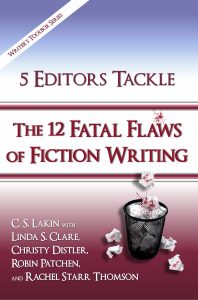Writing Mechanics: Avoiding the “I” Trap and Other Irritants
In today’s post editor Linda Clare continues our look at Fatal Flaw #12: Flawed Writing Mechanics. We’ve taken a look at scene structure, and now we’ll cover some of the smaller bits that jam up the gears of writing mechanics.
This week we’re discussing how poor writing mechanics can lead to dull writing. Let’s examine how repetitive pronoun/proper name use and other small mistakes can weaken fiction and what we can do to strengthen our work.
Get Out of the “I” Trap
In the Julia Roberts/Brad Pitt movie The Mexican, Roberts leans out a window, hurling all Pitt’s possessions on him. He protests, “But I . . . I . . . ”
She yells back. “I, I, I, I, I. It’s always about you, Jerry.” She then throws something else onto his head.
When writers overuse pronouns in their fiction, I think of this scene. Every writer faces the same challenge: how to communicate the story without boring readers by repeating pronouns at the beginning of sentences.
If you look at a scene you’ve drafted and see (or hear) nothing but I,I,I, the passage might read better if you rearrange or revise. Many people have an aversion to hearing “I” repetitively (or “he” or “she” or “it”). My solution is to draft the sentences any way they come, but later revise or rearrange at least half of them.
Before:
I pressed my knuckles against my mouth after the teacher reprimanded me. I couldn’t believe he’d dress me down in front of the whole class! I hadn’t done anything wrong, unless you count that lit firecracker on his chair. I was determined to get revenge, even if it took all semester. I smiled at the real culprits—Tommy and Jack, those evil twins. I was always getting in trouble thanks to those two apes. I’d find a way to get even.
In the Before example, every sentence begins with “I.” It does seem egocentric and, frankly, boring. Let’s see how the paragraph can be reworked.
After:
After the teacher reprimanded me, I pressed my knuckles against my mouth. He’d dressed me down in front of the whole class! I hadn’t done anything wrong, unless you count that lit firecracker on his chair. Even if it took all semester, I’d get revenge. I smiled at the real culprits—Tommy and Jack, those evil twins. Thanks to those two apes, I was always getting in trouble. Getting even became my goal.
To avoid beginning every sentence with “I,” I rearranged a few words, putting the end phrase at the beginning. More importantly, the new arrangements put the important part of the sentence where it has the most impact—at the beginning or the end. If you allow the important part of a sentence to languish in the middle, it tends to get lost.
Emphasize the important stuff where it will have a greater impact—beginning or end—as that’s what readers tend to remember most easily. Plus, you solve the “I” problem.
No Fun with Dick & Jane
Another way names in fiction become troublesome is when characters keep naming the person they’re addressing. In real life, we hardly ever say the name of the person we’re speaking to. And unless it’s a character’s mother yelling her child’s entire name when he’s gotten into trouble, refrain from letting characters repeat proper names. Doing so in fiction results in stilted or artificial dialog.
Before:
“I say, Jane, dear. Would you mind passing the salt?”
“I’d be delighted, Richard.”
“Call me Dick.”
“I can’t do that, Richard Patrick Smith.”
“Jane, is it really necessary to call me by my given name?”
“Yes, Richard, I’m afraid it is.”
Well, then, Jane Harriet Jones, you can go jump in the lake.”
The exchange is obviously silly, but it illustrates the point. Repeating proper names distracts and irritates readers. Name your characters only in the attribution, such as “Jane said,” or a in a beat of action the first time they’re introduced. That way your dialog isn’t overburdened and you can give a complete scenic experience.
After:
Dick leaned across the table. “I say, dear. Would you mind passing the salt?”
Jane looked up. “I’d be delighted, sir. Aren’t you Richard?” She hoped he didn’t recognize her as the upstairs maid.
“Call me Dick.”
“I can’t do that, sir.” Jane bit her lip. Would he expose her?
He peered at her. “Is it really necessary to call me by my given name?”
“Yes, I’m afraid it is. Sir.” She should have stayed upstairs.
He frowned. “Well, then, whoever you are—go jump in the lake.”
There! It! Is!
Writers who begin sentences with “there” or “it” can almost always strengthen those lines by revising. There was or there were indicates passive construction that would be better if replaced by an active verb.
Example: There was an old brick building at the end of the dirt road. Better: An old brick building sat at the end of the dirt road. Not only do you eliminate there and was—two words that can mean many things—you also put the important words at the sentence’s beginning.
In much the same way, “it” buys a writer relatively little in terms of communicating. Plus, the word it tends to refer to the last noun written. Example: It was the neighbor’s dog, prowling around under the window. It growled, then ran off yelping.
To remedy the unfortunate growling window, you could write: Under the window, the neighbor’s dog prowled around. It growled, then ran off yelping.
Lay, Biddy, Lay
No discussion of writing mechanics is complete without mentioning the correct usage of the verbs lay and lie. To lie and to lay are irregular verbs that have a bunch of meanings, but writers most often confuse these two verbs when referring to putting an object or a person down. In everyday speech, the word lay has invaded incorrectly, but when you write, get it right. Here are the correct ways to use lay and lie:
The word lay is easy in present tense. I walk in and lay my keys on the table. Lay needs an object, a “what” that’s being laid. Some people keep it straight by saying, “Hens lay (eggs). People lie (down).
The word lie is trickier when you mean reclining. Have you ever told your dog to “go lay down?” If you’d said, “Go lie down,” Fido might obey better—and you’d be grammatically correct.
Right now I lie in bed, but last night I lay in bed. I had lain awake the night before. In fact all week long I was lying around with insomnia.
Writing skills begin with mechanics. Learn how to vary the pronoun opening; handle proper names effectively; and use strong, specific words. Understand lay vs. lie. Master these and other areas of writing mechanics to help rework so-so fiction to unforgettable fiction.
Your turn:
What is your most troublesome mechanics area, and how do you deal with it in writing? Has this post helped you recognize your “I” problem? What are some ways that help you avoid repetitive or vague pronouns that cause confusion?
~~~~~~~~~~~~~~~~~~~~~~~~~~~~~~~~~~~~
 Have you been learning helpful insights on how to spot flaws in your fiction writing? Know some writers who might benefit from these in-depth posts? The book is out!
Have you been learning helpful insights on how to spot flaws in your fiction writing? Know some writers who might benefit from these in-depth posts? The book is out!
You can find 5 Editors Tackle the 12 Fatal Flaws of Fiction Writing on all online venues, in print or as an ebook.
It’s currently the #1 best seller on Amazon for reference guides-editing!
Here are some links: Kindle, iBooks, Nook, Kobo, Oyster, and Scribd.
Don’t just give any book as a gift this holiday season. Give the book that will help the writers in your life become better writers! They’ll thank you!
Reviewers say:
“I wish I’d had this book when I wrote my first manuscript.”
“Every author needs this book on their shelf. From nothing happening to too much backstory to body parts behaving badly, this book has it all and tells you how to fix it with examples you can follow. Don’t have the money to hire an editor for your novel? Use this book, one of several in the Writer’s Toolbox Series, to mark your own book up in red. The fun part of this book is being able to read each entry and then determining what is wrong with it before you read the answer. Not quite sure what is wrong? That is okay, because the fatal flaw is fixed right before your eyes.”
“Another new and favorite part of the book is the checklist at the end of each chapter. I like having a quick wrap-up to check my work against. It’s great to rifle back through the detailed information after reading, but I’m more likely to use the checklists reminders over and over.”
“I have well over a hundred writing books on my bookcase and dozens more on my Kindle, but Fatal Flaws deserves to become the newest addition.”
“Got a feeling that something’s not quite right in your story? Maybe you don’t even know what it is, but you sense something’s not working? Get this book! It’s a mini-lecture series and workshop taught in a friendly manner. Your writing will significantly improve if you read this book and follow the suggestions.”
“This is an excellent study book for published and non-published writers alike. I love the fact that I got input five different editors. So many teaching books are written by just one person. Besides, where else can you get this much writing instruction for $4.99?”
Exactly! Our thanks to all who did an early read and review. Your comments will help others see the value of this comprehensive book. And may this book help you all to write awesome books in 2016!
~Susanne, Linda, Christy, Robin, and Rachel











One of my biggest problems with mechanics is when to use “who” or “that.” Example: She was the one who came last. I want to write that. I repeatedly catch myself with this one.
The basic rule is “who” is for people and “that” is for things. However, in fantasy sometimes, or even other genres like children’s books, animals can be “whos” as well. It can be a matter of taste (maybe a robot can be a who too).
Lovely insights for fiction. But how does one overcome this challenge while writing non-fiction, about, say, a personal experience?
I’m not sure what you’re asking. But if you mean trying not to say “I” too much, in first person or in a memoir, you are going to be saying/thinking “I” a lot. But you wouldn’t want to start most of your sentences with that pronoun. Varying the style of sentences and how they begin, as well as putting in dialog and external action and description can help balance that. Is that what you’re thinking?
Good stuff! For a novelist, here’s a way to solve the “I” problem: you can go full-on Jay McInerney (_Bright Lights, Big City_) and write your novel in second person. Your sentences will begin with, for example, “You started out on the Upper East Side with
champagne and unlimited prospects ….”
Other successful novels using this technique? None come to mind, probably because second person fiction tends to be jarring — it’s almost impossible to sustain at novel length without your readers’ feeling as though they’ve driven a hard road on bad springs.
McInerney made it work, and I’ve seen a good short story or two written this way. Can you think of any other readable novels written using second-person POV?
I settled on first person for my own just-finished novel because it provided the strongest amplification of my POV character’s voice and gave me the smallest psychic distance from him. But this choice does come with pitfalls, one of which you’ve ably discussed here. Thanks for the good post.
Bruce,
I agree that second person is pretty tricky to do well. My advice is go ahead and try it, but you’ll need a lot of skill to do it well. Thanks for visiting and let me know how your work is going. Keep Writing! ~Linda
Linda, thanks for the reply! I’m not so much a fan of McInerney’s subsequent work, but have to hand it to him for his skillful use of the second person POV in that first book.
I’d probably only use second person for fun, at no more than short story length. Readers do often find it annoying, and I have a standing policy to annoy the reader as little as possible. All the best in your work as well. –Bruce